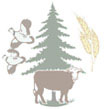Red Cedar, Commodity Verses Product
Items classified as commodities can be described as possessing the following attributes:
First, customers want the cheapest price; second, commodities represent items produced and purchased in high volumes and with high frequency; and third, producers are reliant on the advantages of size and scale to achieve the lowest cost of production and resultant low prices. They are minimally differentiated and the buyers incur no cost to switch from one supplier to another.
Products, in contrast, can be described as items that are value added goods, more differentiated from one another. A product is a "value package" of elements that in combination offer benefits to satisfy customer needs. The more differentiated the products are, the more value they have and the more unique they are perceived. The challenge is to differentiate the products and add value in a way that will beat competitors and build long-term customer relationships.
Redcedar products
In the redcedar market, the companies surveyed buy a large variety of products ranging from standing timber to logs, posts, cants, lumber or by-products. The products and the quantities purchased by the phone survey respondents are presented below (Figure 9). Responses came in a variety of units of measure based on type of product purchased, i.e. board feet, tons, cords, dollars, etc. Based on the results, the largest firms use over 1 million board feet of redcedar annually. Standing timber is the most common product purchased (76%), followed by raw logs (64%) and cants (28%). The results are influenced by the fact that primary manufacturers are the largest group interviewed. The volume purchased annually ranges from less than 1,000 board feet to more than 5 million board feet and from 4,000 tons to 50,000 tons.
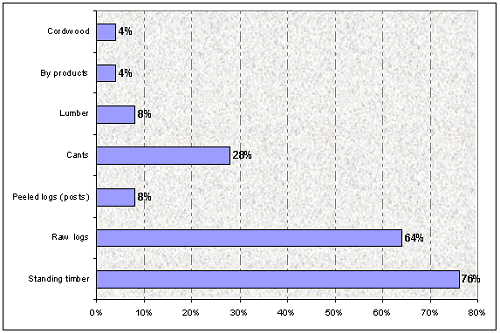
|
| Figure 9: Products purchased (phone survey) |
Forty percent of respondents expect the volume purchased to increase and another 40% expect this volume to stay the same in the next 10 years (Figure 10).
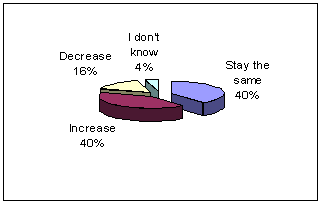
|
| Figure 10: Expectation for volume purchased (phone survey) |
The respondents that expect the volume purchased to increase are located in regions with abundant redcedar (AR, MO, KY)
Redcedar uses
Redcedar has a wide range of uses. Products range from logs, cants, and lumber to furniture, cedar-wood oil, novelties, mulch and shavings (Figure 11).
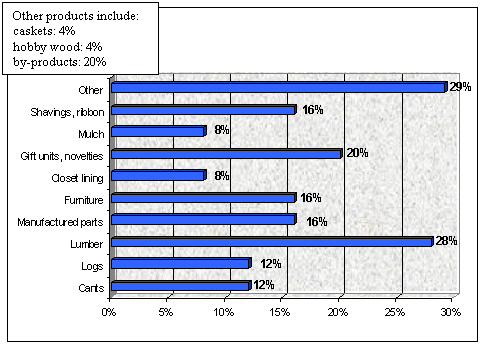
|
| Figure 11: Products sold (phone survey) |
Complete utilization
Both primary and secondary manufacturers surveyed indicated that virtually nothing is wasted with redcedar, every by-product has a market. An excellent example of the full utilization of redcedar material is provided by Giles & Kendall on their web page (http://www.aromaticcedar.com). Large cants are sliced into thin veneer for the furniture and laminated panels industry. Smaller cants are re-sawn and made into tongue and groove planks for closet lining. The smaller diameter trees and large log slabs are typically shaved into pet bedding or hogged into mulch. Waste from the pressboard process is used as fuel for drying the flakes. The small slabs from the sawmill and other log waste are transformed into mulch for landscaping. Sawdust and planer shavings from the sawmill are processed for extracting cedarwood oil for the fragrance industry. Residue, after extraction is used as boiler fuel for generating the steam for the oil process and as space heating in the winter.
Volume
Thirty six percent of the respondents felt that the volume sold is going to stay the same and 24% felt that is going to decrease (Figure 12).
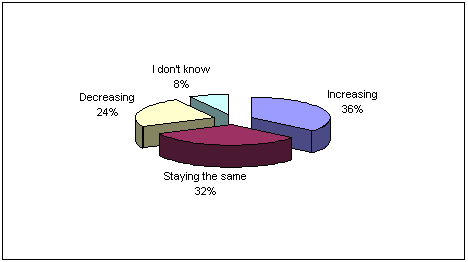
|
| Figure 12: Expectation for volume sold (phone survey) |
A company's perspective on future sales may be influenced by its size in the marketplace. Our survey indicated that the majority of companies with gross annual sales exclusively from redcedar under 1 million expect the volume sold to decrease, while the majority of companies that sell more than one million annually expect the volume sold to increase or stay the same.
The mail survey identified a wider range of products specific to the redcedar market than the phone survey. Fourteen percent of the businesses surveyed indicated that the top product of their operation is dimensional lumber. Another 14% of the survey respondents mentioned that their top product is closet lining. The third most prevalent use of redcedar wood is in animal bedding (about 10%) (Figure 13). The phone survey respondents indicated that their best selling products were: cants, 2x6 lumber, 2x4 lumber, S 4 S lumber, mailbox posts, bird houses and feeders, coffee tables, beds, gift boxes, mulch and shavings. In most cases, the best selling products were also the most profitable ones.
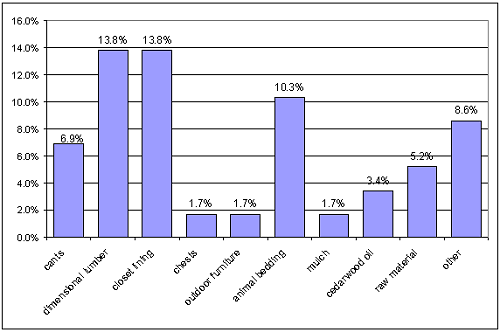
|
| Figure 13: Top redcedar products (mail survey) |
Adding Value
To successfully add value to products, a company must begin by determining the purchasing criteria of their customer(s). The value package must satisfy the specific customer's needs. A company must develop a product and marketing strategy that will increase the bundle of benefits to the customer. For redcedar (Figure 14), value can be added in many ways including:
- Improving product quality by removing defects and maintaining consistently high product standards;
- Increasing the products functionality by promoting and marketing the products unique benefits, e.g., pleasant smell, decay resistance and insect repellant characteristics;
- Changing the form of the product (cutting to size, specialty cutting);
- Making it easier for the customer to obtain the product by arranging for easy acquisition, e.g., deliver the product to the customer or to a location easy for the customer to access;
- Saving the customer time and effort, e.g., break bulk and package the product into smaller units desired by the customers and making it easier for the customer to possess the product, if necessary provide customer training in use of the product.
- Packaging and labeling that helps differentiate the products and build brand loyalty among customers.
Figure 14: Eastern redcedar products
| Eastern Redcedar Products | |
| Logs | Clothes hangers or hooks |
| Cants | Cedar necktie and belt hanger |
| Closet lining /Paneling | Shoe rack, shoe "trees" |
| Fence Posts | Cedar Moth Balls |
| Dimensional lumber | Bird feeders |
| Cedarwood oil | Bird houses |
| Gazebo, cabana | Mailboxes |
| Furniture (chests, beds, drawers, tables, chairs, shelves, wardrobes and closets) | Mailbox posts |
| Outdoor furniture (benches, tables, chaise lounge) | Boxes, novelties |
| Animal bedding | Pencils |
| Mulch | Carvings |
| Wood turnings | Wreaths |
| Canes | Wood chips |
An example of how the price of products expresses the value that is added along the value chain for redcedar products is presented in Figure 15.
Figure 15: Value added to eastern redcedar products
| Eastern Redcedar Products - $ Value Added | |
| Products | Unit Price |
| Solid Wood | |
| Logs | $250 -$350/ MBF |
| Cants | $500 / MBF |
| Paneling | $1,800 /MBF |
| Bird feeders | $10...$20 / unit (retail price) |
| Mailboxes | $32.19 /unit (retail price) |
| Mailbox posts | $19.83 ... $24.97 (retail price) |
| Gazebo | $2,395...$6,795(retail price) |
| Square Cabana | $2,995...$9,295 (retail price) |
| Chairs | $245 (cedar + cypress) (retail price) |
| Rocking gliders | $385-$535 (cedar + cypress) |
| Dining Table | $315 (cedar + cypress) |
| Decorative shelves | $56.99 (retail price) |
| Cedar Chests | $259 - $2,493 (sizes 24"...72") (retail price) |
| Beds | $750...$1086 (retail price) |
| By-Products | |
| Cedar Hook | $7.99 / sets of four - protects and deodorizes clothes (retail price) |
| Cedar tie and belt hanger | $29.99/unit (retail price) |
| Cedar Moth Balls | $5.99 (24 pack) (retail price) |
| Animal Bedding | |
| Dog bedding compressed bail | $22 /bail (retail price) |
| Premier Pet Redcedar Bedding | $9.99 (5 cu ft) (retail price) |
| L/M animal farms bedding | $4.49 (700 cu in) (retail price) |
| Mulch | |
| Retail: | $30.95/cu. Yd. |
| Contractor: | $ 28.95/cu. Yd. |
| Distillates | |
| Cedarwood oil | $1.83 (5 ml)...$27.61 (16 oz) for aromatherapy |
| $6/lb drum quantity, $9/lb less than one drum - for perfume and cosmetic industry and household use (improve fragrance and moth resistance properties in closets and dressers) | |
| $7.95 (10ml) (on line store) for aromatherapy | |

